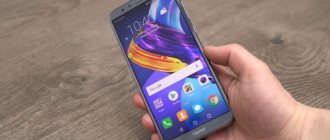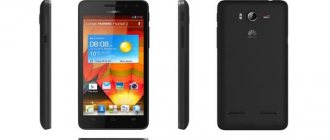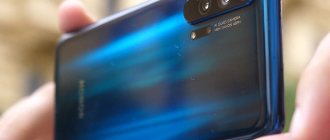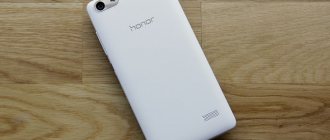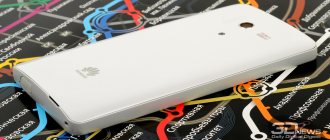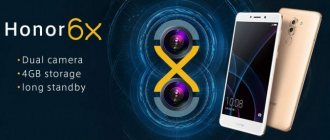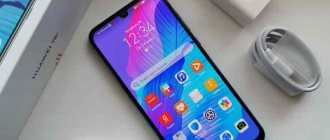The main question that involuntarily arises in your head when you get acquainted with the technical characteristics of the new Huawei Honor 7: why was it necessary to release it if there is an almost identical one? Seriously, analyze the two right columns of the table below - you will see that the Honor 7 and Huawei P8 are very, very similar. The fact is that in its homeland, China, Honor is already a separate brand, aimed at young people, and distributed exclusively via the Internet, due to which it is possible to reduce the final cost of the devices.
The line of devices, which was previously called Huawei Ascend P, and now simply Huawei P, was the top one in the company’s range and remains so. This means that the P8 is a gadget made with a focus on design and image. It stands on the polished display windows of trading floors, and there, in these same trading floors, they ask for money as for a full-fledged flagship smartphone. Let's put it simply: Honor 7 was originally made cheaper than P8. In Russia, the current price for the “seven” is 23 thousand rubles, and for the premium P8 – 30 thousand. Let's try to figure out what Huawei engineers saved on when creating Honor 7...
⇡#Technical characteristics
| Huawei Honor 6 | Huawei Honor 6 Plus | Huawei Honor 7 | Huawei P8 | |
| Touch screen | 5 inches, 1920 × 1080 pixels, IPS; 445 dpi; capacitive, up to ten simultaneous touches | 5.5 inches, 1920 × 1080 pixels, IPS; 401 dpi; capacitive, up to ten simultaneous touches | 5.2 inches, 1920 × 1080 pixels, IPS; 423.6 dpi; capacitive, up to ten simultaneous touches | 5.2 inches, 1920 × 1080 pixels, IPS; 423.6 dpi; capacitive, up to ten simultaneous touches |
| Air gap | No | No | No | No |
| Oleophobic coating | Eat | Eat | Eat | Eat |
| Polarizing filter | Eat | Eat | Eat | Eat |
| Factory film | No | No | No | No |
| System-on-a-chip | HiSilicon Kirin 920 (ARM big.LITTLE architecture): four ARM Cortex-A15 cores, 1.7 GHz + four ARM Cortex-A7 cores, 1.3 GHz (ARMv7), 28 nm process technology; 32-bit computing | HiSilicon Kirin 925 (ARM big.LITTLE HMP architecture): four ARM Cortex-A15 cores, 1.8 GHz + four ARM Cortex-A7 cores, 1.3 GHz (ARMv7) + Smart i3 coprocessor, 28 nm HPm process technology; 32-bit computing | HiSilicon Kirin 935 (ARM big.LITTLE HMP architecture): four ARM Cortex-A53 cores, 1.5 GHz frequency + four ARM Cortex-A53e cores, 2.2 GHz frequency (ARMv8) 28 nm HPm process technology; 32-bit and 64-bit computing | HiSilicon Kirin 930 (ARM big.LITTLE HMP architecture): four ARM Cortex-A53 cores, 1.5 GHz frequency + four ARM Cortex-A53e cores, 2 GHz frequency (ARMv8) 28 nm HPm process technology; 32-bit and 64-bit computing |
| Graphics controller | ARM Mali-T628 MP4, frequency 600 MHz | ARM Mali-T628 MP4, frequency 600 MHz | ARM Mali-T628 MP4, frequency 600 MHz | ARM Mali-T628 MP4, frequency 600 MHz |
| RAM | 3 GB LPDDR3-1600 | 3 GB LPDDR3-1600 | 3 GB LPDDR3-1600 | 3 GB LPDDR3-1600 |
| Flash memory | 16 GB (11.5 GB available to user) + microSD | 16/32 GB (we tested a 32 GB version - 25.1 GB available to the user) + microSD | 16/32/64 GB (we tested a 16 GB version - 10.7 GB available to the user) + microSD | 16/32 GB (we tested a 16 GB version - 11.3 GB available to the user) + microSD |
| Connectors | 1 × Micro-USB 2.0 1 × 3.5 mm headset jack 1 × MicroSD 1 × Micro-SIM | 1 × Micro-USB 2.0 1 × 3.5 mm headset jack 1 × Micro-SIM 1 × Nano-SIM/microSD (combined) | 1 × Micro-USB 2.0 1 × 3.5 mm headset jack 1 × Nano-SIM 1 × Nano-SIM/microSD (combined) | 1 × Micro-USB 2.0 1 × 3.5 mm headset jack 1 × Nano-SIM 1 × Nano-SIM/microSD (combined) |
| cellular | 2G/3G/4G One SIM card in Micro-SIM format | 2G/3G/4G* One SIM card in Micro-SIM format + one SIM card in Nano-SIM format, which can be replaced with a microSD memory card | 2G/3G/4G One Nano-SIM format SIM card + one Nano-SIM format SIM card, instead of which you can install a microSD memory card | 2G/3G/4G One Nano-SIM format SIM card + one Nano-SIM format SIM card, instead of which you can install a microSD memory card |
| Cellular connection 2G | GSM/GPRS/EDGE 850/900/1800/1900 MHz | GSM/GPRS/EDGE 900/1800/1900 MHz | GSM/GPRS/EDGE 850/900/1800/1900 MHz | GSM/GPRS/EDGE 850/900/1800/1900 MHz |
| Cellular 3G | DC-HSPA+ (42.2/5.76 Mbps) 900/2100 MHz | HSDPA (42.2/5.76 Mbps) 850/900/1900/2100 MHz TD-SCDMA 1900/2000 MHz | HSDPA (42.2/5.76 Mbps) 900/1900/2100 MHz TD-SCDMA 1900/2000 MHz | HSDPA (42.2/5.76 Mbps) 900/1900/2100 MHz TD-SCDMA 1900/2000 MHz |
| Cellular 4G | LTE Cat. 6 (300/50 Mbps) FDD: Band 1, 3, 7, 20 (2100/1800/900/800 MHz), TDD: Band 38 (2600 MHz) | LTE Cat. 6 (300/50 Mbps) Band 1, 3, 7, 38, 39, 40, 41 (2100/1800/2600/1900/2300/2500 MHz) | LTE Cat. 6 (300/50 Mbps) Band 1, 3, 7, 8, 20 (2100/1800/2600/900/800 MHz) | LTE Cat. 6 (300/50 Mbps) Band 1, 2, 3, 4, 5, 7, 8, 12, 17, 18, 19, 20, 25, 26, 28, 40 (2100/900/1800/1700/ 850/2600/900/700/800/2300 MHz) |
| WiFi | 802.11a/b/g/n, 2.4 and 5 GHz + Wi-Fi Direct | 802.11a/b/g/n, 2.4 and 5 GHz + Wi-Fi Direct | 802.11a/b/g/n, 2.4 and 5 GHz + Wi-Fi Direct | 802.11a/b/g/n, 2.4 and 5 GHz + Wi-Fi Direct |
| Bluetooth | 4.0 + A2DP | 4.0 + A2DP | 4.1 | 4.1 |
| NFC | No | Yes - only for the version with LTE | No | No |
| IR port | Yes | Yes | Yes | No |
| Navigation | GPS, A-GPS, GLONASS | GPS, A-GPS, GLONASS | GPS, A-GPS, GLONASS | GPS, A-GPS, GLONASS |
| Sensors | Light sensor, proximity sensor, accelerometer/gyroscope, magnetometer (digital compass) | Light sensor, proximity sensor, accelerometer/gyroscope, magnetometer (digital compass) | Light sensor, proximity sensor, accelerometer/gyroscope, magnetometer (digital compass) | Light sensor, proximity sensor, accelerometer/gyroscope, magnetometer (digital compass) |
| Fingerprint's scanner | No | No | Yes | No |
| Main camera | 13 MP (4160 × 3120), Sony Exmor RS CMOS sensor with back-illumination, Autofocus, single LED flash | Dual, 8 MP sensors (3264 × 2448), Software image stitching up to 13 MP, Autofocus, dual LED flash | 20 MP (5152 × 3888), Sony Exmor RS CMOS sensor with back-illumination, Autofocus, dual LED flash | 13 MP (4160 × 3120), Sony Exmor RS CMOS sensor with back-illumination, Autofocus, single LED flash |
| Front-camera | 5.1 MP (2592 × 1952), no autofocus | 8 MP (3264 × 2448), no autofocus | 8 MP (3264 × 2448), no autofocus | 8 MP (3264 × 2448), no autofocus |
| Nutrition | Non-removable battery: 11.78 Wh (3100 mAh, 3.8 V) | Non-removable battery: 13.68 Wh (3600 mAh, 3.8 V) | Non-removable battery: 11.78 Wh (3100 mAh, 3.8 V) | Non-removable battery: 10.18 Wh (2680 mAh, 3.8 V) |
| Size | 140 × 70 mm Case thickness: 7.5 mm | 150.5 × 75.7 mm Case thickness 7.5 mm | 143 × 72 mm Case thickness 8.5 mm | 145 × 72 mm Case thickness 6.4 mm |
| Weight | 130 g | 165 g | 157 g | 144 g |
| Housing protection | No | No | No | No |
| operating system | Android 4.4.2 Own shell EmotionUI 2.3 | Google Android 4.4.2 (KitKat) Own shell EmotionUI 3.0 | Google Android 5.0.2 (Lollipop) Own shell EmotionUI 4.0 | Google Android 5.0.2 (Lollipop) Own shell EmotionUI 3.1 |
| Current price | 19,990 rubles | 22,990 rubles for the 16 GB version 25,990 rubles for the 32 GB version | 22,990 rubles | 26,990 rubles |
* There is a version of Huawei Honor 6 Plus without LTE support, but it is not officially supplied to Russia. It has strictly 16 GB of built-in flash memory, while the version with LTE support can be equipped with 16 or 32 GB of memory. Accordingly, when purchasing a version with 16 GB of flash memory, just in case, it is worth checking whether this copy has LTE support.
| Honor 7 – information about the system and hardware according to the CPU-Z application | ||||
⇡#Appearance, ergonomics, fingerprint scanner
Huawei engineers have finally made the body of the next Honor series smartphone metal. And this, in general, is a significant event - previously the cases of gadgets of this family were plastic. This is where the good news regarding appearance probably ends and the ordinary news begins. The fact is that Honor 7 looks, to put it more precisely, mediocre - it can easily get lost among other Android smartphones. This is probably what the creators originally intended, because for the sake of image, there are P-series devices. Nevertheless, the appearance of the “seven” is rather boring – there is literally nothing for the eye to catch on to.
Huawei Honor 7 – front panel
The dimensions of the gadget are also quite standard, as is the weight - 157 grams. Your hands don’t get tired of it, even if you hold the device suspended for a long time. The thickness of the case is 8.5 millimeters. Most competitors are thinner. On the one hand, this does not seem to be very good for our test subject, but on the other hand, a fairly capacious battery of 11.78 Wh (3100 mAh, 3.8 V) fits in its body, so this thickness is justified .
Huawei Honor 7 – front panel
There are no hardware keys on the front panel - the operating system navigation buttons are virtual. At the top of the panel there is a slot for the earpiece, the sensitive area of the light sensor and the lens of the front eight-megapixel camera.
Huawei Honor 7 – front panel
Another interesting feature in the exterior of Honor 7 is the “smart” key. This is a hardware button located on the left side, under the middle finger of the right hand. The key is programmable; the user can assign an action to it (activate the camera, turn on the flash, launch the voice recorder, etc.) or launch an application. It is noteworthy that on this one key you can “hang” three tasks at once - single press, double press and hold. A very convenient feature, I must say.
| Huawei Honor 7 – “smart” key | ||||
Next to this very “smart” key there is a slot for installing two cards – Nano-SIM and a combined slot for Nano-SIM/microSD. Unfortunately, the smartphone, like many other Huawei devices, does not have a separate slot for a memory card.
Huawei Honor 7 – left side
The layout of the controls and connectors on the smartphone is standard. The power and volume keys are located on the right side. On the top edge there is an IR port and a 3.5 mm audio jack, and on the bottom there is a Micro-USB interface and an external speaker. The latter is not blocked by your hand, even if you hold the gadget horizontally.
| Huawei Honor 7 – side ends | ||
Another little surprise awaits on the back panel. Under the lens of the main 20-megapixel camera there is a biometric sensor, which was not previously available in Honor. But something similar was in the Huawei Ascend Mate 7 smartphone, released a year ago.
Huawei Honor 7 – fingerprint scanner
It is noteworthy that with its help you can not only unlock the device, but also answer calls, turn off the alarm, view the list of open applications (to do this, you need to swipe up on the sensor), open the notification panel (swipe down) and erase notifications (double tap on sensor). Moreover, the user can create a protected area for storing confidential information and classified applications, which will be accessed using a fingerprint - through a special section in the built-in file manager. The fingerprint sensor works quite quickly and, most importantly, accurately - on the official Huawei website it says 0.5 seconds for recognition, and this seems to be true. During testing, it unmistakably recognized the owner’s finger and did not react to “strangers.” In total, you can save up to five prints in the device memory.
| Huawei Honor 7 – biometric sensor parameters | ||
The main camera lens protrudes somewhat from the body, which is aesthetically not very pleasant. However, this does not cause any inconvenience: it will not be scratched, even if the device is lying on the table with its back down - there is a metal edging around the protective glass. Next to the camera is a two-section LED flash. We had no complaints about the assembly - the device does not creak or bend, although it does not leave the feeling of an expensive thing either.
Huawei Honor 7 – back panel
Software
The appearance of the EMUI 3.1 software shell, based on Android 5.0.2, is quite far from the Material design minimalism promoted by Google and was definitely developed with iOS in mind. Installed applications here go directly to the main screen, where they can be grouped into folders or hidden out of sight in a special section. The ability to place folders and widgets on desktops has also not disappeared.
In general, it seems that the creators of the shell tried to provide for everything. EMUI has a built-in utility for clearing data remaining after uninstalling programs, a variety of design themes, a special simplified launcher, obviously designed for older users, a power saving mode, a notification manager, a pre-installed Swype keyboard, voice activation for quickly finding a lost phone nearby, and a control mode for one hand.
We should also say a few words about the fingerprint sensor. It works quickly and accurately, stores up to five fingerprints and can serve not only to unlock the phone, but also to protect individual applications and, in some cases, even as a touchpad.
True, among the variety of EMUI 3.1 functions, there are also dubious ones, for example, karaoke or a special camera mode designed for photographing food. The interface is illogical in places, and it’s difficult to find the right item in it if you’re not used to it. Another oddity that appears in several places at once is the “menu” buttons hiding one single settings item.
But the main problem with EMUI 3.1 is the built-in task killer, which carefully suggests which applications consume a lot of energy in standby mode and freezes them along with all child processes, as a result of which, for example, push-up notifications stop receiving. Even applications added to the exclusion list periodically stop updating in the background if you accidentally swipe them from the running list.
⇡#Display
The display characteristics of the Honor 7 are in many ways similar to the display characteristics of the Huawei P8. In particular, they have the same screen diagonals and resolution - both gadgets have 5.2-inch Full HD displays. They have the same pixel density, 423.6 inches. This is a fairly high value - the picture on the screens looks sharp. There is no “pixelation” effect - individual dots on the Honor 7 display cannot be seen, even if you bring the device close to your eyes. You can see this if you look closely at the photo of the display below - the image is quite “smooth”.
Huawei Honor 7 – fragment of screen photo without compression
Huawei has still not installed a Quad HD display (2560 × 1440) in any of its devices - neither in the technologically advanced Honor 7, nor in the fashionable P8. A matrix with this resolution is already used by all the major players in the Android smartphone market - LG (, ), and Samsung (S6/S6 Edge), and HTC (One M9+), and Lenovo, and many other manufacturers, including the second tier . But Huawei’s first smartphone with Quad HD resolution is just about to go on sale – it will be the Nexus 6P.
The display installed in Honor 7 is made using IPS (in-plane switching) technology. Its viewing angles are quite wide - it’s quite comfortable to watch, say, movies and photos on the display together. There are no serious color deviations or shifts, or significant drops in contrast when looking away from the perpendicular. The screen is quite responsive, it responds quickly to touches and recognizes gestures without problems. In total, the device supports up to ten simultaneous touches. The gadget also easily understands touches with loose gloves - this is especially important before winter.
| Huawei Honor 7 – display settings | ||||
The protective glass of the front panel has an oleophobic coating, so it’s pleasant to touch the screen of the “seven”. During operation, it practically does not get dirty: even if the user left “fingers” on the display, it is not difficult to get rid of them using any cloth at hand. The Honor 7 screen is made using One Glass Solution (OGS) technology, that is, there is no air gap between the protective glass and the matrix, which reduces the number of reflections. A very effective polarizing filter also helps combat glare.
The backlight boundaries of the Honor 7 display are quite wide: the luminosity of the white field varies from 12 to 438 cd/m2. These brightness values allow you to comfortably use the device both in complete darkness and in the sun. The gadget is equipped with a light sensor, thanks to which it can independently adjust the brightness level that is comfortable for working in given conditions. The sensor works quite correctly.
The luminosity of the black field is small: at maximum brightness it reaches 0.33 cd/m2. This is a good indicator for an IPS matrix - the black color looks quite deep at any brightness, including maximum, without deviations into dark gray, dark purple or some other dark color. The contrast of the Honor 7 display is very good by the standards of mobile IPS – 1327:1.
Huawei Honor 7 – Grayscale Color Temperature
The color temperature of shades of gray is slightly higher than the reference value of 6500 K - on average it is 7500 K. Evenness is also not all smooth - very light and very dark tones are colder than the intermediate ones, and in general the picture is a little cold. If desired, the user can correct this in the display settings menu.
| Huawei Honor 7 – gamma curve of gray color (left) and color components (right) in comparison with the reference curve (indicated by dotted line) | ||
All gamma curves coincide with the reference curve - the smartphone display displays various halftones and shades correctly. That is, everything is fine with the display, except that the color temperature is too high - we have no other comments.
Display
The 5.2-inch FullHD IPS display of Huawei Honor 7 has average brightness, good viewing angles, uniform illumination and slightly unnatural color reproduction in the spirit of AMOLED technology. When the gaze deviates from the perpendicular, the saturation of black color is generally lost.
The touch layer supports glove mode and knuckle recognition - in theory, you can use them to take a screenshot and even cut and save a certain area of the screen, but this function works very poorly.
It is possible to adjust the thermal balance of the picture. Automatic brightness adjustment works sensitively and changes the screen backlight in a timely manner.
⇡#Hardware and performance
It’s easy to guess the technical content of Huawei smartphones and tablets in advance. This is how we reasoned in the case of Honor 7. The processor most likely will be a chip from a subsidiary of HiSilicon. Since the smartphone is intended for demanding young people, Huawei will most likely install the most powerful available solution in it - the eight-core Kirin 935 chip. This is actually what happened. We would like to draw your attention to the fact that even the fashionable Huawei P8 has the Kirin 930 installed. However, the difference between them is not very significant: the frequency of the Cortex-A53e cores is 2 GHz and 2.2 GHz, but the Cortex-A53 cores operate at the same frequency - 1.5 GHz. However, the very fact that Honor 7 has a more powerful system-on-chip is surprising.
General synthetic tests - AnTuTu Benchmark 5 and GeekBench 3 - clearly demonstrated the superiority of Honor 7 over Huawei P8: the new product is really more powerful. For example, in the AnTuTu task, “seven” scored more than 49 thousand points, while P8 scored less than 44 thousand points. At the same time, even the most powerful, the 935th Kirin, is significantly slower than the new monster from MediaTek (Helio X10 MT6795T, which runs the HTC One M9+). Look at the scores in the GeekBench 3 test: how dare we say it, One M9+ boldly beats Honor 7: five thousand points in a multi-threaded task versus three and a half!
Huawei P8 and Honor 7 have three gigabytes of RAM. Of course, fast LPDDR3 modules are used. The built-in storage capacity of the S7 test unit is sixteen gigabytes, of which less than eleven are available to the user. There are 32 and 64 GB versions for different markets, but whether they will be officially sold in Russia is not known. The user can install a microSD memory card instead of a second SIM card; there is no separate slot for a flash drive.
When performing everyday, mundane tasks, the Honor 7 behaves well. Literally a couple of times during testing, it barely noticeably froze - let's hope that this is a flaw in our pre-production sample.
The graphics controller in the Kirin 935 is the same as in the 930, and in the 925, and in the 920 – ARM Mali-T628 MP4, operating at 600 MHz. This solution, as you probably already guessed, is far from the first freshness. Therefore, it is not at all surprising that resource-intensive 3D toys on the Honor 7 are somewhat slow. Of course, this can be partially solved by reducing the graphics settings to medium or initial, but even this will not completely correct the situation. Honor 7 is not for gamers.
⇡#Communications and wireless communications
As we have already said, the device can work with two Nano-SIM cards - the second SIM card is installed instead of a memory card. It is noteworthy and important that the smartphone has two separate radio modules installed - they work according to the Dual SIM Dual Active scheme, that is, when any activity occurs on one of the cards (for example, an incoming call), the second does not go offline. Working with SIM cards is implemented in the simplest way: after installing both SIM cards in the device, the smartphone will offer to assign which one to call, send messages and access the Internet with.
Honor 7 – SIM card management
The gadget can work in fourth generation networks – LTE Cat.6 is supported. The maximum theoretical data reception speed in mobile networks is 300 Mbit/s, upload speed is 50 Mbit/s. All bands important for Russia have been implemented - there should be no problems with 4G reception, regardless of the operator. In general, the smartphone reliably receives signals from mobile networks and does not lose it for no apparent reason. It is noteworthy that Honor 7 has a software option that allows you to improve the quality of signal reception - it is called “Signal+”.
| Honor 7 – improving signal quality | ||
In terms of wireless interfaces, Honor 7 is equipped almost to the maximum. The device supports Wi-Fi of all more or less popular protocols at frequencies of 2.4 and 5 GHz, Bluetooth 4.1 and is even equipped with an infrared port designed to control household appliances - for this it even has its own, quite convenient application called “Virtual remote controller". It is very easy to work with: the user must select the type of household appliance, find the desired manufacturer in a fairly large list, test the functionality of the proposed code and save the device. After this simple procedure, the treasured virtual control panel will appear. And all this is fine and wonderful, but the version that arrived in our test laboratory does not have NFC. Probably, modifications intended for other countries have support for Near Field Communication, as is sometimes the case with Huawei. However, our version did not have NFC - we double checked.
| Honor 7 – built-in Virtual Remote application | ||
The smartphone has a navigation module installed that can communicate with GPS and GLONASS satellites. We have no complaints about his work. A minute after launching the profile test, the gadget detected eleven satellites, but it used only five of them to determine its location. The error radius was moderate - within 8-12 meters, that is, he was oriented quite accurately.
| Honor 7 – AndroiTS GPS Test results outdoors | ||
Appearance
The first thing you notice when you pick up this device is the material of the case. According to the manufacturer, it is aluminum with ceramic coating, thanks to which the lid and ends of the device have acquired a matte tint. The chamfer between them has not received any spraying and shines beautifully in the light. The only plastic parts here are large corrugated inserts at the top and bottom, under which the wireless modules are hidden. The solution is not the most elegant, but practical - this way nothing will interfere with signal reception. The joints of the plastic and metal parts fit perfectly, but the plastic of the test sample was slightly worn in places.
Above the embossed “Honor” logo is a fingerprint sensor pad and a camera module protruding from the body, paired with a dual flash. There seems to be no need to worry about the safety of his lenses, despite the not very good location. Not only is it surrounded by a special edge, it is also covered with sapphire crystal. The only pity is that it prevents the phone from lying flat on flat surfaces.
The front panel is entirely covered with tempered Gorilla Glass 3, which has proven itself to be excellent protection against minor scratches. The frames that enclose the screen are quite small, with a little more space left at the bottom than at the top.
On either side of the earpiece are the front camera and flash. On the left there is also a block of light/proximity sensors, which is almost impossible to see against a black background. The notification LED is also well hidden, winking at the user from the speaker slot. Because of this location, its glow cannot be seen even at a distance of a meter from the phone lying on the table.
There is no empty space on the side faces of Honor 7. On the right are the volume rocker and the power key, on the left is an additional programmable button that reacts differently to single, double and long presses, as well as a slot for SIM cards. On the bottom edge of the smartphone, there are holes in the plastic insert for the speaker and microphone, and there is also a Micro-USB port. On top, in addition to the standard audio jack and noise reduction microphone, there is an infrared port designed to control household appliances.
Thanks to the metal body and fairly heavy weight, Huawei Honor 7 gives the impression of a solid candy bar, more suitable for men's hands than women's.
⇡#Camera
The Honor 7 has a flagship camera set: the front camera is eight-megapixel, without autofocus, but with a number of interesting software filters. For example, it has a “perfect selfie” mode, in which the user can carefully retouch their own self-portrait: smooth out skin unevenness, make eyes smaller or larger, make them brighter, and so on. The retouching result is displayed in real time. The front camera of Honor 7 takes good pictures even in artificial light.
Honor 7 – front camera effects
The main camera of the gadget has a 20-megapixel sensor – these are rarely installed in mid-priced smartphones; usually this is the prerogative of flagship models. It is equipped with an automatic focusing system and dual LED flash.
Honor 7 – main camera
The rear camera of the smartphone takes good pictures. The automation quickly and accurately aims at the object and quite correctly selects parameters for different shooting conditions - there is no need to set the settings manually. Photos are obtained with natural colors, contrasting and sharp. The level of detail practically does not drop towards the edges of the frame, which is undoubtedly good. In bright light, photos come out very detailed. In the dark, the picture turns out a little “soapy” - the software algorithms fight noise too aggressively, but this is quite forgivable. We have no other comments about the rear camera.
Huawei Honor 7
View all images (5)⇡#Autonomous work
We have already noted that Honor 7 has a fairly capacious battery – 11.78 Wh (3100 mAh, 3.8 V). For a 5.2-inch smartphone, this is a perfectly acceptable battery. It is enough for the owner to spend a working day or even a day away from the outlet, provided that he at least sometimes lets go of the smartphone. During testing, Honor 7 did not leave us without a connection even once – and this is definitely good. A full charging cycle takes just under three hours; the gadget is powered by Micro-USB.
In our traditional test for HD video playback at maximum screen brightness, the device lasted more than six and a half hours, which is a very respectable result. At the same time, of course, its wireless modules were turned on, and data (applications, mail, and so on) was updated in the background via Wi-Fi. If you lower the display backlight level, the smartphone's battery will be enough to watch a movie throughout the entire transatlantic flight, without interruption.
| Honor 7 – power saving options | ||
Honor 7, like other Huawei devices, has three scenarios for using the battery with quite self-explanatory names: (auto-adjusting processor power depending on the task being performed) and energy-saving. The user also has the ability to automatically turn off Wi-Fi when the device is in sleep mode. In general, if you adjust the energy saving settings to suit your needs, you can extend the life of the battery by an hour or two.
| Honor 7 – power settings | ||||
Let's sum it up
Whatever one may say, Huawei Honor 7 turned out to be very interesting and its many advantages outweigh the few disadvantages. It looks even more attractive considering the increased prices for the flagships of other companies. The only category of users that this smartphone will disappoint are gamers looking for a mobile gaming platform for the next couple of years. Others who want to get a 5.2-inch screen in a relatively compact aluminum case, support for two SIM cards and a capacious battery for relatively little money should pay close attention to Huawei Honor 7.
Pros:
- Metal body;
- Powerful central processor;
- Capacious battery;
- Fast and functional fingerprint sensor;
- Two radio modules.
Minuses:
- Not the fastest graphics core;
- Slow "cold start" GPS.
May not like:
- Combined SIM/SD card slot;
- Unnatural screen color rendering;
- Camera module protruding from the body.
⇡#Conclusions
We chose the title “not enough honor” for this material for one reason: Honor 7 is too disrespectful to older Huawei smartphones. Seriously, let's face it: with the same P8, Mate S and others like them, he did what the first Volkswagen Golf GTI did with sports cars of the same time - he made them meaningless. Honor 7 is fast enough, it has many wireless interfaces, it can work with two SIM cards, it has good cameras, decent battery life, it is equipped with a good display... and official resellers are asking 23 thousand rubles for it at the start of sales! Yes, let's admit, he doesn't have a very expressive appearance. But for the above-mentioned gadgets, it is also not so outstanding that you overpay for it. This suggests a logical conclusion: why pay more? The conclusion was short, but that’s probably all we would like to say about Honor 7.



